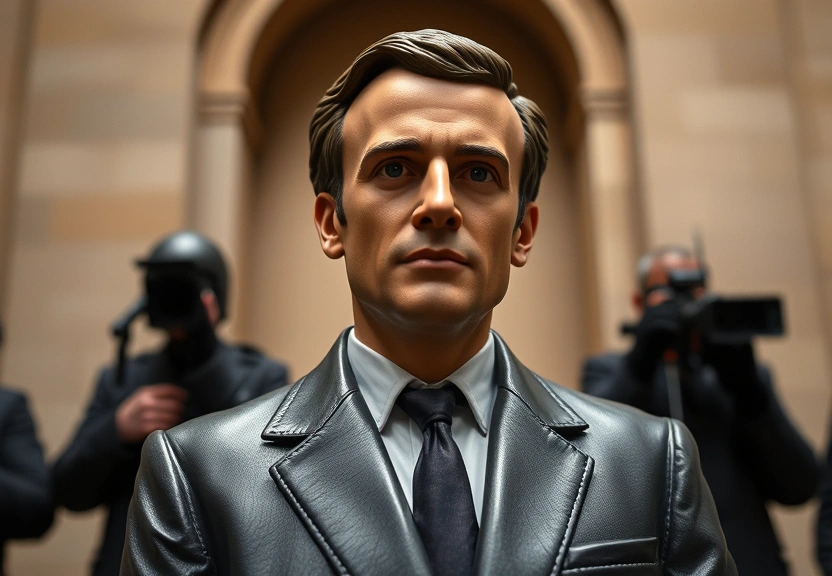Macron Wax Statue Stolen from Paris Museum for Anti-Russian Protest
In a bold act of political protest, Greenpeace activists took a wax statue of French President Emmanuel Macron from a Paris museum and placed it outside the Russian embassy on a recent Monday. This dramatic move was aimed at drawing attention to the ongoing business ties between France and Russia, as well as critiquing Macron’s climate policies. The protest has sparked discussions around international relations, environmental responsibility, and public activism.

As the world grapples with the implications of political decisions on climate change, this demonstration underscores the urgent need for leaders to prioritize environmental issues over economic interests. In this article, we will explore the motivations behind this protest, the significance of the statue, and the broader context of Macron’s climate policies and his relationship with Russia.
The Context of the Protest
Greenpeace is known for its direct action campaigns aimed at raising awareness about environmental issues and holding governments accountable. The decision to target Macron’s statue is not coincidental; it reflects a growing frustration among activists regarding the perceived inaction on climate change and the continued partnership with countries that have questionable environmental practices. This protest also comes at a time when the war in Ukraine has amplified scrutiny of Western nations’ ties with Russia.
Macron’s Business Ties with Russia
Despite the ongoing conflict in Ukraine, France has maintained certain economic ties with Russia, which has raised eyebrows among environmental activists and the public alike. These ties often contradict the urgent calls for climate action, as fossil fuel dependency remains a significant concern in both countries.
- France’s reliance on Russian gas and oil has been a contentious issue.
- Macron’s administration has faced criticism for not taking a stronger stand against fossil fuel investments.
- The ongoing war has complicated international relations and has prompted calls for energy independence.
The Significance of the Macron Statue
The wax statue of Emmanuel Macron, typically housed in a museum, symbolizes not only the president himself but also the broader political climate in France. By removing the statue and placing it in front of the Russian embassy, Greenpeace sought to make a statement about the disconnect between Macron’s public persona and the actions of his government. The statue, while a representation of a public figure, also serves as a metaphor for the perceived failure of leadership in addressing climate issues effectively.
Public Reaction to the Protest
The reaction to the protest has been mixed. Some view it as a necessary action to draw attention to pressing issues, while others criticize it as an extreme measure that undermines legitimate discourse. Nonetheless, the event has sparked conversations online and in the media regarding the balance between environmental activism and political responsibility.
- Supporters argue that direct action is often necessary to provoke change.
- Critics contend that such actions can alienate potential allies in the fight against climate change.
- Public opinion appears to be divided on the effectiveness of such protests.
Macron’s Climate Policies Under Scrutiny
As a leader, Emmanuel Macron has positioned himself as a champion for climate action. However, the effectiveness of his policies has come under scrutiny, especially in light of the recent protest. Activists argue that his government has not done enough to transition to renewable energy sources and reduce reliance on fossil fuels.
Key Climate Initiatives and Challenges
Macron’s administration has launched several initiatives aimed at combating climate change, including:
- The Climate and Resilience Law: Aimed at reducing greenhouse gas emissions and increasing resilience to climate impacts.
- Investment in renewable energy: Significant funds have been allocated to develop solar and wind energy projects.
- Commitment to international agreements: Macron has been vocal about France’s commitment to the Paris Agreement and global climate action.
Despite these initiatives, challenges remain:
- Resistance from the fossil fuel industry has slowed progress on renewable energy projects.
- Public protests, like those from the Yellow Vests movement, have highlighted the social implications of environmental policies.
- Critics argue that Macron’s policies are not ambitious enough to meet the urgent demands of climate science.
The Broader Implications of Political Protests
The protest involving Macron’s wax statue raises significant questions about the role of activism in democratic societies. As citizens increasingly feel that their voices are not being heard, actions like these can serve as a catalyst for broader discussions about governance, accountability, and the responsibilities of public officials.
The Role of Activism in Shaping Policy
Activism plays a crucial role in shaping public policy by:
- Raising awareness about important issues that may be overlooked by mainstream media.
- Encouraging public dialogue and debate, which can lead to policy change.
- Holding governments accountable for their actions and commitments.
However, the effectiveness of activism often depends on public perception and the ability to engage a wider audience. Striking the right balance between direct action and constructive dialogue remains a critical challenge for activists.
Frequently Asked Questions (FAQ)
1. What was the purpose of the Greenpeace protest involving Macron’s statue?
The protest aimed to criticize the ongoing business ties between France and Russia and highlight the shortcomings of Macron’s climate policies.
2. How did the public react to the protest?
Public reaction has been mixed, with some supporting the protest as a necessary action and others criticizing it as extreme and counterproductive.
3. What are Macron’s key climate policies?
Macron’s key climate initiatives include the Climate and Resilience Law, investment in renewable energy, and commitment to international agreements like the Paris Agreement.
4. How does the protest relate to international relations?
The protest highlights the complexities of international relations, particularly in balancing economic ties with countries like Russia against the urgent need for climate action.
5. What is the role of activism in promoting policy change?
Activism can raise awareness, foster public dialogue, and hold governments accountable, but its effectiveness often depends on public perception and engagement.
Conclusion
The Greenpeace protest involving Emmanuel Macron’s wax statue serves as a powerful reminder of the urgent need for accountability in climate policies and international relations. As activists continue to challenge leaders to prioritize environmental issues, the conversation around business ties with countries like Russia will undoubtedly persist. In a world facing the stark realities of climate change, the intersection of activism and policy will be crucial in shaping a sustainable future. Leaders must listen to their constituents and respond with meaningful action, or risk facing the consequences of public dissent.
📰 Original Source
Este artigo foi baseado em informações de: https://www.cnn.com/2025/06/03/style/greenpeace-macron-statue-scli-intl


